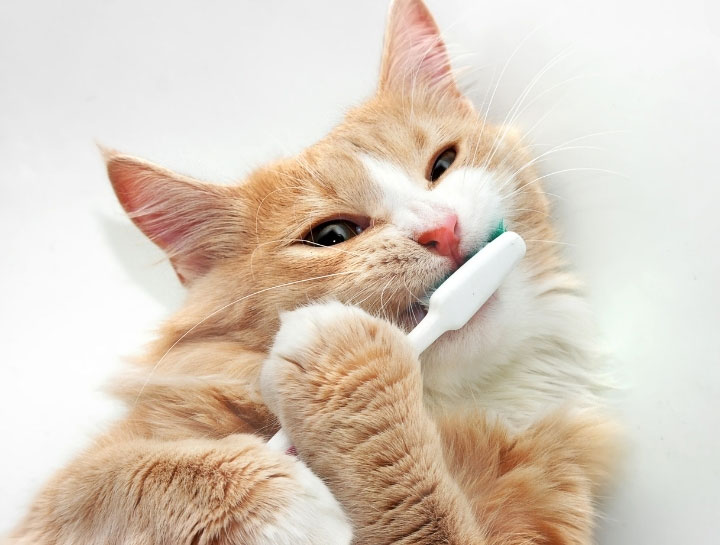Dental Care at Home

Brushing or rubbing plaque off the teeth is best done after meals every 12 to 48 hours. We suggest cleaning every evening after eating and before sleep. Soft-bristled tooth brushes made for pets or people are best, however, rubber finger brushes and even pieces of gauze over the finger can work well. Toothpastes made for pets are flavored to promote acceptance of the procedure. The following is an approach developed for cats, however, some dogs may require a similar approach:
- Get your pet familiar to the sight and smell of the toothbrush and paste. Put a little tasty toothpaste on the brush and set it down. Allow the pet to explore this on its own. You can try putting a little paste on your finger and let the pet lick it off. Most animals love the taste! You will want to follow this session up with a reward such as a favorite treat or lots of praise. It is important to link the activity to the reward for future compliance. Do this once a day for a week.
- In week two, you will place a little paste on your finger and gently dab it on the canine tooth (a fang tooth). An upper tooth will likely be the easiest. Go slow and relax. Follow with a treat afterward and lots of praise. Do this step once daily for one week.
- In the third week, you will load up the toothbrush with some paste and hold this up to the pet’s mouth. Allow your pet to lick the paste off the bristles. Do not forget a treat afterwards and lots of praise. Do this step once daily for one week.
- The final step will be when you are actually brushing your pet’s teeth. Lift the lip up and hold the brush at a 45 degree angle. Slide the brush over the cheek teeth concentrating your efforts on the surface between the tooth and gum tissue. Do not use pressure or force! A gentle rubbing will be enough to disrupt the plaque on the tooth’s surface. Brush both sides and then finish with a quick rub over the front teeth (the incisors). Do not worry about the insides of the teeth – the tongue acts as a brush to those areas. Make sure to follow up with a special treat and praise.
A new development in pet dental care is Oravet. This is a barrier sealant that alters the polarity or electric charge on the tooth surface. This prevents bacteria and plaque from adhering. The teeth are treated by re-application at home weekly, where a thin layer is applied with a finger. Please inquire for a demonstration on your pet.
Diet Selection
Simply put, large pieces of dry crunchy food help keep the teeth the cleanest. This provides more abrasion and oral motion than small pieces, canned or soft moist (burger) type foods. The best teeth cleaning formulations have pieces the size of a walnut for large dogs and correspondingly smaller sizes for small dogs and cats. These are puff kibbles and penetrate further, scraping the sides of the tooth like an apple does for us. They can be used as treats between meals also. Let us know if you are interested in trying them.
Treat Selection
Not all treats or chew toys are safe and effective at cleaning teeth. Hooves, hard plastic, and natural bones can all lead to broken or fractured teeth in strong chewers like many medium and large breed dogs. Soft treats often contain large amounts of sugar and stick to the teeth. These are especially popular for cats. Rawhide “chips” that are about the size of an index card are best. Similarly, the compressed cigar-shapped sticks are good too and both can be given twice daily without gastrointestinal upset. Larger rawhides eaten quickly can create diarrhea, so you must know your dog. Softened compressed bones, such as greenies, may be of some dental benefit, but should be withheld from dogs that swallow large pieces without chewing.
